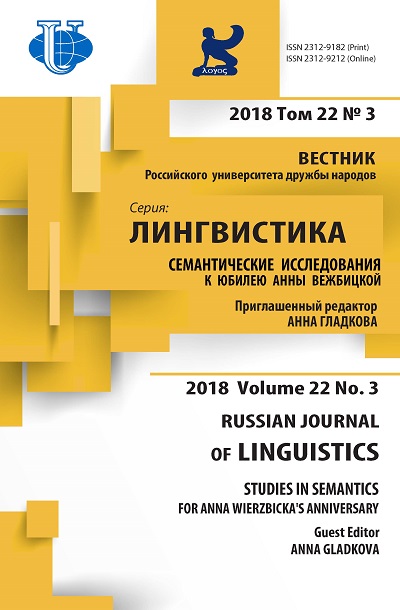Russian Constructions with Syntactic Reduplication of Colour Terms: A Corpus Study
- Authors: Apresjan V.Y.1,2
-
Affiliations:
- National Research University Higher School of Economics
- Vinogradov Russian Language Institute of the Russian Academy of Sciences
- Issue: Vol 22, No 3 (2018): Studies in semantics: for Anna Wierzbicka’s anniversary
- Pages: 653-674
- Section: STUDIES IN SEMANTICS: For Anna Wierzbicka’s anniversary
- URL: https://journals.rudn.ru/linguistics/article/view/19351
- DOI: https://doi.org/10.22363/2312-9182-2018-22-3-653-674
- ID: 19351
Cite item
Full Text
Abstract
Keywords
About the authors
Valentina Yur'evna Apresjan
National Research University Higher School of Economics; Vinogradov Russian Language Institute of the Russian Academy of Sciences
Email: vapresyan@hse.ru
currently working as an Associate Professor at the National Research University “Higher School of Economics” (School of Linguistics), as well as the leading researcher at Vinogradov Russian Language Institute (Sector for Theoretical Semantics). She received her Ph.D from the University of Southern California (Emotion conceptualization in Language, 1996), and her Dr. Habilitatus degree from Vinogradov Russian Language Institute (Formation and Interaction of Compex Meanings in Language, 2015). Valentina Apresjan taught at USC (1994-1996), AlpenAdria-Universität Klagenfurt (2000), Russian State University of Humanities (2008-2010), Dartmouth College (2010-2012, 2016-2018). Her research interests include semantics, pragmatics, semantic typology, lexicography, constructions. 20 Myasnitskaya st., Moscow, 101000, Russia; 18/2 Volkhonka st., Moscow, 119019, Russia
References
- Apresjan, J. (2006). The foundations of systemic lexicography. Linguistic picture of the world and systemic lexicography. Moscow: Yazyki slavyanskikh kul'tur. (In Russ.).
- Apresjan, V., Baisa V., Buivolova O., Kultepina O., Maloletnjaja A., Iskhakov T., Suchomel V. (2016). RuSkELL: Online Language Learning Tool for Russian Language. In T. Margalitadze,
- G. Miladze (eds.), Proceedings of the XVII Euralex International Congress, 292-299. Berlin B., Kay, P. (1969). Basic Colour Terms: their Universality and Evolution. UCP Press.
- Bulygina, T.V., Shmelev, A.D. (1997). Yazykovaya kontseptualizatsiya mira (na materiale russkoi grammatiki) (Linguistic conceptualization of the world (from the evidence of the Russian grammar)). Moscow: Shkola “Yazyki russkoi kul'tury”. (In Russ.).
- Davies, I., Corbett, G. (1994). The basic colour terms of Russian. Linguistics, 32(1), 65-90.
- Feldstein, R.F. (2016). On Russian concessive-adverstaive constructions with pronominal reduplication of the type “Uzh chem-chem, a etim ego ne udivish”. In Trudy Instituta russkogo yazyka im. V.V. Vinogradova (The working papers of Vinogradov Russian Language Institute), 11, 329-342. Moscow.
- Gilyarova, K.A. (2015). Takaya devochka-devochka. Semantika reduplikatsii sushchestvitel'nykh v russkoi razgovornoi rechi i yazyke internet (Such a girl-girl. Semantics of noun reduplication in colloquial Russian and the Internet language). In Dialogue’2015, Computer Linguistics and Intellectual Technologies, 90-96. (In Russ.).
- Iomdin, L.L. (2003). Bol’shie problemy malogo sintaksisa (Big problems of the minor syntax). In Computational Linguistics and Intellectual Technologies: Proceedings of the International Conference “Dialog”, 216-222. (In Russ.).
- Iomdin, L. (2010). Sintaksicheskie frazemy: mezhdu leksikoi i sintaksisom (Syntactic phrasemes: between lexicon and syntax). In Apresjan Ju. (ed.), Teoreticheskie problemy russkogo sintaksisa: vzaimodeistvie grammatiki i slovarya (Theoretical problems of the Russian syntax: interaction of grammar and lexicon). Moscow: Yazyki slavyanskikh kul’tur, 141-190. (In Russ.).
- Iomdin, L.L. (2013). Chitat' ne chital, no...: ob odnoi russkoi konstruktsii s povtoryayushchimisya slovesnymi elementami (I haven’t read it but...about one Russian construction with repeated elements). In Computational Linguistics and Intellectual Technologies: Proceedings of the International Conference “Dialog”, 12 (19), 297-310. (In Russ.).
- Israeli, A. (1997). Syntactic Reduplication in Russian: A Cooperative Principle Device in Dialogues. Journal of Pragmatics 27, 587-609.
- Kilgarriff, A., Baisa, V., Bušta, J., Jakubíček M., Kovář V., Michelfeit J., Rychlý P., Suchomel V. (2014). The Sketch Engine: ten years on. Lexicography, 1 (1), 7-36.
- Kryuchkova, O.Yu. (2004). Voprosy lingvisticheskoi traktovki leksicheskoi reduplikatsii v russkom yazyke (The issues of linguistic interpretation of lexical reduplication in the Russian language). Russkii yazyk v nauchnom osveshchenii [Russian Language and Linguistic Theory], 2(8), 63-83. (In Russ.).
- Lyashevskaya, O. N., Sharov, S. A. (2009). Chastotnyj slovar' sovremennogo russkogo jazyka (na materialah Nacional'nogo korpusa russkogo jazyka) [Frequency Dictionary of Modern Russian Language (on the material of the National Corpus of the Russian language)]. Moscow: Azbukovnik. (In Russ.).
- Paillard, D., Plungian, V. A. (1993). Ob odnom tipe konstruktsii s povtorom glagola v russkom yazyke (On a type of constructions with the repetition of verbs in Russian). Russian Linguistics, 17 (3), 263-277. (In Russ.).
- Paramei, G. (2005). Singing the Russian blues: An argument for culturally basic colour terms. CrossCultural Research, 39, 10-38.
- Paramei, G. (2007). Russian ‘blues’: Controversies of basicness. In R.E. MacLaury, G.V. Paramei, & D. Dedrick (eds.), Anthropology of colour: Interdisciplinary multilevel modeling, 75-106. Amsterdam: John Benjamins.
- Plungjan, V. A., Rakhilina, E. V. (2010). Tushat-tushat - ne potushat: grammatika odnoi glagol'noi konstruktsii (Tushat-tushat - ne potushat: the Grammar of one Verbal Construction). In Rakhilina E. V. (ed.), Lingvistika konstruktsii (Construction Linguistics), 83-94. Moscow: Azbukovnik. (In Russ.).
- Stefanowitsch, A., Gries S. 2003. Collostructions: Investigating the interaction between words and constructions. International Journal of Corpus Linguistics, 8(2), 209-43.
- Vilinbakhova, E. L. (2015). Stat'ya znachit stat'ya: ob odnom klasse tavtologicheskikh konstruktsii v russkom yazyke (An article means an article: on one class of tautological constructions in Russian). In Computational Linguistics and Intellectual Technologies: Proceedings of the International Conference “Dialog”, 1(14), 2, 638-649. (In Russ.).
- Wierzbicka, A. (1990). The meaning of colour terms: Semantics, culture, and cognition. Cognitive Linguistics, 1(1), 99-150.
- Wierzbicka, A. (2003). Cross-cultural Pragmatics: The Semantics of Human Interaction. 2-nd edition.Mouton de Gruyter.
- Wierzbicka, A. (2005). There Are No “Colour Universals” but There Are Universals of Visual Semantics. Anthropological Linguistics, 47(2) (Summer, 2005), 217-244.
- Wierzbicka, A. (2008). Why There Are No 'Colour Universals' in Language and Thought. The Journal of the Royal Anthropological Institute, Vol. 14, No. 2 (Jun., 2008), 407-425.
- Wierzbicka, A. (2013). Imprisoned in English. The Hazards of English as a Default Language. Oxford University Press.
- Winawer, J., Witthoft, N., Frank, N.C., Wu L., Wade A.R. and L. Boroditsky. (2007). Russian blues reveal effects of language on colour discrimination. Proceedings of the national academy of sciences, 104 (19), 7780-7785.
Supplementary files















